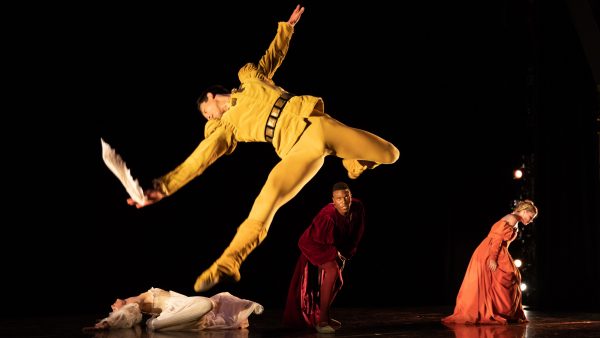Dance Review: José Limón Company at Jacob’s Pillow — Empowering and Necessary
By Mary Paula Hunter
Kudos to Jacob’s Pillow for this stellar beginning to a digital season of dance.

Jacob’s Pillow 2020 Digital Season — The José Limón Company.
Jacob’s Pillow 2020 Digital Season begins with a backward glance, treating viewers to a 2018 presentation by The José Limón Company. With this stellar performance of three historically significant works, The Pillow reminds us that — during the pandemic and after — it will continue to be the premier preserver of the legacy of modern dance.
Integral to the history of modern dance, Limón proves the enduring power of his artistry well after his distinct style and technique have faded from their once central place in any consideration of the art form. Admittedly, his choreography is neither revelatory nor dazzling, but Limón’s trust in humankind’s goodness — expressed mainly through the poetry of distilled movement — remains as relevant as ever. We see none of Martha Graham’s now dated examination of the heteronormative; Limón and dancers treat us to an inclusive vision that, in our current climate, does not come off as naive, but necessary and empowering.
The opener, Chaconne (1942), begins with Limón in a somewhat blurry film, performing a solo he created for himself to a Bach violin solo (Partita No. 2 in D). With his back to us, he looks as if he is expanding like a massive tree, tilting slightly, his arms encircling and then wrapping around space. Rather than decorative, these weighted gestures define volume in an exploration of the natural world and our place within it.
Eventually, the film fades and the connection between Limón and the current company members is established. The solo becomes a trio for two men and a woman. By fragmenting the solo, the current company acknowledges the founder as perhaps inimitable, but also asserts the flexibility of his oeuvre’s vision. The original solo, which was rooted and stately, now morphs into an expression of pure movement that cascades across the entire stage.
Throughout the piece, highly trained dancers commit themselves to choreography inspired by human experience — breathing, spinning, and falling. Their movements speak to an earlier and perhaps less cynical period in dance history.
Spiraling turns illustrate a trust in the torso as a source for these rotations. The wide, uncrossed position in the feet (fourth position) supports swiveling turns on both feet while curved torsos unfurl in low jumps that descend smoothly to the floor. There is less of the legendary fall and recovery — the hallmark of the Humphrey Limón technique — than in the final dance entitled Suite from a Choreographic Offering, but moments of suspension pop throughout a dance dedicated to exploring the very humanness of movement.
Limón’s masterpiece, The Moor’s Pavane (1949), is a compact account of Shakespeare’s Othello. Jealousy, the work’s theme, is expressed via pure movement — when facial expressions are brought in the work is at its weakest. Enhanced by Purcell’s composite score and Pauline Lawrence’s elegant gowns, this piece is dance theater at its most powerfully abstract.
The four dancers (Othello, Othello’s wife, his friend, his friend’s wife) begin moving decorously, as couples. A cautiousness creeps into their skimming steps; soon their crossings lose any sense of abandon. The pairs break apart and then Limón proves his mastery of creating spatial architecture. As their trusting relationships disintegrate, their travels about the stage become unpredictable and erratic. At one moment, his friend lands on Othello’s back — a lizard dropped from the sky.
Opposing the scheming friend is his wife, whose elegant movements become increasingly forced as she tries to control her plotting husband. Othello, disbelieving his spouse’s alleged betrayal, brushes his leg up in the air dangerously near his friend before dropping it to the floor in strong defiance. His spiraling turns become brittle. The iconic handkerchief, stolen from his wife, convinces Othello of her infidelity. Before she falls after his slicing murderous attack, his bewildered wife appears to be suspended in air.
The final work, Suite from A Choreographic Offering, was created in honor of Limón’s mentor and eventual collaborator, Doris Humphrey. The work is inspired by her devotion to the study of dance composition and performed to Bach’s A Musical Offering (Bach, much like Philip Glass today, became an overused source for dance composition). It is an exuberant ode to choreographic or compositional studies.
Groupings vary from trios to solos to large ensembles, each presented frontally as if expecting a critical reaction from the analytical Humphrey (she wrote the influential book on composition, The Art of Making Dances). Aspects of rhythm are explored along with examinations of stage design, facings, and vertical dimensions, from low to high.
Dancers suspend, fall, and recover, illustrating the principle of breath, which is central to Humphrey’s technique. Spirals to the floor dominate one part of the Suite, reminding the viewer that Paul Taylor’s vocabulary and his optimism descend from the work of Humphrey and Limón.
Kudos to Jacob’s Pillow for this stellar beginning to a digital season of dance — an art form that depends on the life breath of bodies in motion.
Mary Paula Hunter lives in Providence, RI. She’s the 2014 Pell Award Winner for service to the Arts in RI. She is a choreographer and a writer who creates and performs her own text-based movement pieces. In 2019 Hunter published Someone Else, a novel set in her hometown of East Lansing, Michigan.
